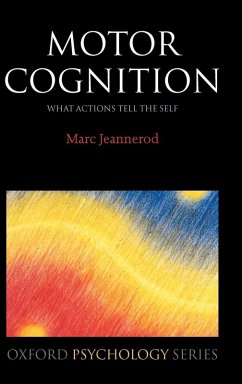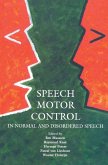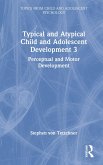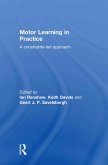- Gebundenes Buch
- Merkliste
- Auf die Merkliste
- Bewerten Bewerten
- Teilen
- Produkt teilen
- Produkterinnerung
- Produkterinnerung
'Motor Cognition' describes the field of motor cognition - one to which the author's contribution has been seminal. The book examines how the motor actions we perform and watch others perform play a pivotal role in the construction of the 'self' - our ability to acknowledge and recognise our own identity.
Andere Kunden interessierten sich auch für
![SPEECH MOTOR CONTROL C SPEECH MOTOR CONTROL C]() MaassenSPEECH MOTOR CONTROL C231,99 €
MaassenSPEECH MOTOR CONTROL C231,99 €![Routledge International Handbook of Visual-motor skills, Handwriting, and Spelling Routledge International Handbook of Visual-motor skills, Handwriting, and Spelling]() Routledge International Handbook of Visual-motor skills, Handwriting, and Spelling269,99 €
Routledge International Handbook of Visual-motor skills, Handwriting, and Spelling269,99 €![Typical and Atypical Child Development 3 Perceptual and Motor Development Typical and Atypical Child Development 3 Perceptual and Motor Development]() Stephen Von TetzchnerTypical and Atypical Child Development 3 Perceptual and Motor Development174,99 €
Stephen Von TetzchnerTypical and Atypical Child Development 3 Perceptual and Motor Development174,99 €![Human Nature and Suffering Human Nature and Suffering]() Paul GilbertHuman Nature and Suffering205,99 €
Paul GilbertHuman Nature and Suffering205,99 €![Motor learning in healthy and Parkinsonian adults Motor learning in healthy and Parkinsonian adults]() Chiara Di NuzzoMotor learning in healthy and Parkinsonian adults37,99 €
Chiara Di NuzzoMotor learning in healthy and Parkinsonian adults37,99 €![The Influence Of Caffein On Mental And Motor Efficiency (1912) The Influence Of Caffein On Mental And Motor Efficiency (1912)]() Harry Levi HollingworthThe Influence Of Caffein On Mental And Motor Efficiency (1912)23,99 €
Harry Levi HollingworthThe Influence Of Caffein On Mental And Motor Efficiency (1912)23,99 €![Motor Learning in Practice Motor Learning in Practice]() Motor Learning in Practice195,99 €
Motor Learning in Practice195,99 €-
-
-
'Motor Cognition' describes the field of motor cognition - one to which the author's contribution has been seminal. The book examines how the motor actions we perform and watch others perform play a pivotal role in the construction of the 'self' - our ability to acknowledge and recognise our own identity.
Produktdetails
- Produktdetails
- Verlag: OUP Oxford
- Seitenzahl: 220
- Erscheinungstermin: 29. Juni 2006
- Englisch
- Abmessung: 240mm x 161mm x 17mm
- Gewicht: 499g
- ISBN-13: 9780198569640
- ISBN-10: 0198569645
- Artikelnr.: 21056893
- Herstellerkennzeichnung
- Libri GmbH
- Europaallee 1
- 36244 Bad Hersfeld
- gpsr@libri.de
- Verlag: OUP Oxford
- Seitenzahl: 220
- Erscheinungstermin: 29. Juni 2006
- Englisch
- Abmessung: 240mm x 161mm x 17mm
- Gewicht: 499g
- ISBN-13: 9780198569640
- ISBN-10: 0198569645
- Artikelnr.: 21056893
- Herstellerkennzeichnung
- Libri GmbH
- Europaallee 1
- 36244 Bad Hersfeld
- gpsr@libri.de
Marc Jeannerod, born in Lyon, France. Doctor in Medicine (1965), Thesis in Lyon, on sleep mechanisms. Post-doc at the Brain Research Institute, UCLA, Los Angeles (California). Professor in Physiology at the University Claude Bernard, Lyon. Runs his own lab on sensory-motor coordination, until 1997. 1997-2005: Founder and Director of the Institut des Sciences Cognitives, Lyon. In this Institute, works on the mechanisms of the generation of actions Member, Académie des Sciences.
* 1: Representations for actions
* 1.1: Definitions
* 1.2: Neural models of action representations
* 1.3: Functional models of action representation
* 2: Imagined actions as a prototypical form of action representation
* 2.1: The kinematic content of motor images
* 2.2: Dynamic changes in physiological parameters during motor imagery
* 2.3: The functional anatomy of motor images
* 2.4: The consequences of the embodiment of action representations
* 3: Consciousness of self-produced actions and intentions
* 3.1: Consciousness of actions
* 3.2: Consciousness of intentions
* 4: The sense of agency and the self/other distinction
* 4.1: Sense of ownership and sense of agency in self-identification
* 4.2: The nature of the mechanism for self-identification
* 4.3: The problem of the self/other distinction
* 4.4: Failure of self-recognition/attribution mechanisms in
pathological states
* 5: How do we perceive and understand the actions of others
* 5.1: The perception of faces and bodies
* 5.2: The perception of biological motion
* 5.3: The understanding of others' actions
* 5.4: Functional implications of the mirror system in motor cognition
* 5.5: The role of the mirror system in action imitation
* 6: The simulation hypothesis of motor cognition
* 6.1: Motor simulation: a hypothesis for explaining action
representations
* 6.2: Motor cognition and social cognition
* 6.3: Motor simulation and language understanding
* Conclusion
* 1.1: Definitions
* 1.2: Neural models of action representations
* 1.3: Functional models of action representation
* 2: Imagined actions as a prototypical form of action representation
* 2.1: The kinematic content of motor images
* 2.2: Dynamic changes in physiological parameters during motor imagery
* 2.3: The functional anatomy of motor images
* 2.4: The consequences of the embodiment of action representations
* 3: Consciousness of self-produced actions and intentions
* 3.1: Consciousness of actions
* 3.2: Consciousness of intentions
* 4: The sense of agency and the self/other distinction
* 4.1: Sense of ownership and sense of agency in self-identification
* 4.2: The nature of the mechanism for self-identification
* 4.3: The problem of the self/other distinction
* 4.4: Failure of self-recognition/attribution mechanisms in
pathological states
* 5: How do we perceive and understand the actions of others
* 5.1: The perception of faces and bodies
* 5.2: The perception of biological motion
* 5.3: The understanding of others' actions
* 5.4: Functional implications of the mirror system in motor cognition
* 5.5: The role of the mirror system in action imitation
* 6: The simulation hypothesis of motor cognition
* 6.1: Motor simulation: a hypothesis for explaining action
representations
* 6.2: Motor cognition and social cognition
* 6.3: Motor simulation and language understanding
* Conclusion
* 1: Representations for actions
* 1.1: Definitions
* 1.2: Neural models of action representations
* 1.3: Functional models of action representation
* 2: Imagined actions as a prototypical form of action representation
* 2.1: The kinematic content of motor images
* 2.2: Dynamic changes in physiological parameters during motor imagery
* 2.3: The functional anatomy of motor images
* 2.4: The consequences of the embodiment of action representations
* 3: Consciousness of self-produced actions and intentions
* 3.1: Consciousness of actions
* 3.2: Consciousness of intentions
* 4: The sense of agency and the self/other distinction
* 4.1: Sense of ownership and sense of agency in self-identification
* 4.2: The nature of the mechanism for self-identification
* 4.3: The problem of the self/other distinction
* 4.4: Failure of self-recognition/attribution mechanisms in
pathological states
* 5: How do we perceive and understand the actions of others
* 5.1: The perception of faces and bodies
* 5.2: The perception of biological motion
* 5.3: The understanding of others' actions
* 5.4: Functional implications of the mirror system in motor cognition
* 5.5: The role of the mirror system in action imitation
* 6: The simulation hypothesis of motor cognition
* 6.1: Motor simulation: a hypothesis for explaining action
representations
* 6.2: Motor cognition and social cognition
* 6.3: Motor simulation and language understanding
* Conclusion
* 1.1: Definitions
* 1.2: Neural models of action representations
* 1.3: Functional models of action representation
* 2: Imagined actions as a prototypical form of action representation
* 2.1: The kinematic content of motor images
* 2.2: Dynamic changes in physiological parameters during motor imagery
* 2.3: The functional anatomy of motor images
* 2.4: The consequences of the embodiment of action representations
* 3: Consciousness of self-produced actions and intentions
* 3.1: Consciousness of actions
* 3.2: Consciousness of intentions
* 4: The sense of agency and the self/other distinction
* 4.1: Sense of ownership and sense of agency in self-identification
* 4.2: The nature of the mechanism for self-identification
* 4.3: The problem of the self/other distinction
* 4.4: Failure of self-recognition/attribution mechanisms in
pathological states
* 5: How do we perceive and understand the actions of others
* 5.1: The perception of faces and bodies
* 5.2: The perception of biological motion
* 5.3: The understanding of others' actions
* 5.4: Functional implications of the mirror system in motor cognition
* 5.5: The role of the mirror system in action imitation
* 6: The simulation hypothesis of motor cognition
* 6.1: Motor simulation: a hypothesis for explaining action
representations
* 6.2: Motor cognition and social cognition
* 6.3: Motor simulation and language understanding
* Conclusion









